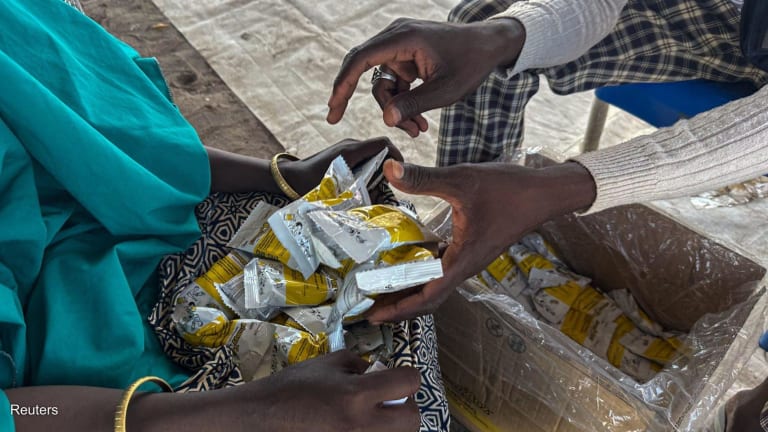
UNITED NATIONS — Babies in low- and middle-income countries are much more likely to be breastfed than young children in high-income countries due to variation in government policy, social support, and public perception, according to a new United Nations Children’s Fund analysis released Thursday.
Just 4 percent of babies in low- and middle-income countries are never breastfed, while 21 percent of babies in high-income countries never receive breastmilk.
The gap is higher than some experts may have expected, said Maaike Arts, an early childhood nutrition specialist at UNICEF.
“I have to say, that when we actually looked at numbers and added it up, when we came to 21 percent of babies in high-income countries that are never breastfeed — that was quite high.”
New UN guidance aims to boost exclusive breastfeeding worldwide
Better data monitoring and country ownership over exclusive breastfeeding plans are key to making the practice more widespread, the United Nations Children's Fund and World Health Organization say.
The new findings — which are based on public government data — come shortly after UNICEF and the World Health Organization released an updated version of guidelines that aim to boost global breastfeeding rates, and to certify health facilities as “baby-friendly” — trained in breastfeeding support practices. Breastfeeding — especially when that is the exclusive nutrition for babies under 6 months — has multiple health benefits for both mother and child, but is not always a feasible option for women, given factors including short parental work leave.
In high-income countries, multiple factors contribute to the relatively low rates.
“You can say there are social and cultural issues, but it also the lack of support that is there for mothers. We hear time and time again that mothers do intend to breastfeed, and for one reason or another it doesn't happen,” Arts explained. “Those reasons are national policies, support for mothers at the time of delivery and health centers, regulation on the marketing of infant formula, and issues related to maternity leave. Women can think, ‘Why bother even to get started if I need to go back to work soon?’”
Barriers to breastfeeding vary by country, and there is a wide spread in success among high-income countries. While almost all babies are breastfed in Oman, Sweden, and Uruguay, about 74 percent of babies get breast milk in the United States. That figure drops to 55 percent in Ireland.
The U.S. accounts for more than one-third of the 2.6 million babies in high-income countries who are never breastfed.
“We know that wealthy mothers in poor countries are less likely to breastfeed, but somewhat paradoxically, we’re seeing indications that in wealthy countries, it’s the poor who are the least likely.”
— Shahida Azfar, deputy executive director of UNICEFIn some high-income countries, poor women are less likely to breastfeed, a reversal of trends seen in some low- and middle-income countries.
“We know that wealthy mothers in poor countries are less likely to breastfeed, but somewhat paradoxically, we’re seeing indications that in wealthy countries, it’s the poor who are the least likely,” said Shahida Azfar, UNICEF’s deputy executive director, in a media release. “These breastfeeding gaps across income levels are a strong indication that countries, regardless of the level of wealth, are not informing and empowering every mother to breastfeed her baby.”
Socioeconomic gaps are not as prominent in low- and middle-income countries, where 9 out of 10 babies are breastfed. Household wealth, though, can indicate how long a baby is likely to be breastfed — 64 percent of toddlers at the age of 2 in the poorest households, compared to 41 percent of toddlers in the richest.
Babies in low- and middle-income countries who do not receive breastmilk are not necessarily consuming formula products as a substitute. Drinks made from maize and wheat flour, as well as animal milk, are all common, according to Arts.
“On the socioeconomic aspect, it [formula] is quite expensive, even in high-income countries, where people have the means to buy it. In the longer run, it is more the issue of overall support and perceptions,” Arts said. “It’s also information that the family has access to. You see that often in high-income countries — it leads families to think that there is not a big difference between breastfeeding and formula feeding and formula feeding might just look easier.”
“It comes down, again, to: What are the policies? Is the government proactive in promoting breastfeeding? What is out there in terms of information?”
Recent government initiatives to promote breastfeeding, along with regulations on marketing formula, have helped to boost the rates in countries such as Ghana and Vietnam in recent years.
“They [Vietnam and Ghana] have quite a comprehensive legislation on the marketing of breastmilk substitutes. Many other countries are not that far. The United States does not have regulations in place, and in many countries in Europe they are bound by a directive that does not cover all the aspects. There are wide variations in how the international code is adopted,” Arts said.


